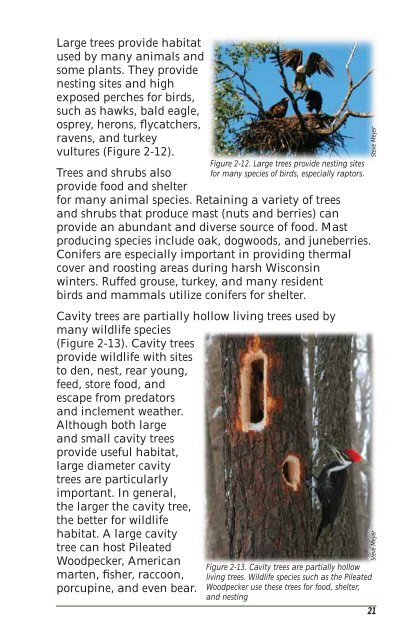Wisconsin's Forestland Woody Biomass Harvesting Guidelines
Wisconsin's Forestland Woody Biomass Harvesting Guidelines
Wisconsin's Forestland Woody Biomass Harvesting Guidelines
Create successful ePaper yourself
Turn your PDF publications into a flip-book with our unique Google optimized e-Paper software.
Large trees provide habitat<br />
used by many animals and<br />
some plants. They provide<br />
nesting sites and high<br />
exposed perches for birds,<br />
such as hawks, bald eagle,<br />
osprey, herons, fl ycatchers,<br />
ravens, and turkey<br />
vultures (Figure 2-12).<br />
Figure 2-12. Large trees provide nesting sites<br />
for many species of birds, especially raptors.<br />
Trees and shrubs also<br />
provide food and shelter<br />
for many animal species. Retaining a variety of trees<br />
and shrubs that produce mast (nuts and berries) can<br />
provide an abundant and diverse source of food. Mast<br />
producing species include oak, dogwoods, and juneberries.<br />
Conifers are especially important in providing thermal<br />
cover and roosting areas during harsh Wisconsin<br />
winters. Ruffed grouse, turkey, and many resident<br />
birds and mammals utilize conifers for shelter.<br />
Cavity trees are partially hollow living trees used by<br />
many wildlife species<br />
(Figure 2-13). Cavity trees<br />
provide wildlife with sites<br />
to den, nest, rear young,<br />
feed, store food, and<br />
escape from predators<br />
and inclement weather.<br />
Although both large<br />
and small cavity trees<br />
provide useful habitat,<br />
large diameter cavity<br />
trees are particularly<br />
important. In general,<br />
the larger the cavity tree,<br />
the better for wildlife<br />
habitat. A large cavity<br />
tree can host Pileated<br />
Woodpecker, American<br />
marten, fi sher, raccoon,<br />
porcupine, and even bear.<br />
Figure 2-13. Cavity trees are partially hollow<br />
living trees. Wildlife species such as the Pileated<br />
Woodpecker use these trees for food, shelter,<br />
and nesting<br />
21<br />
Steve Meyer Steve Meyer


